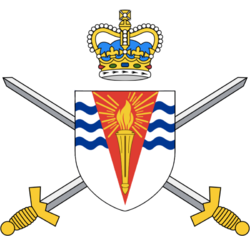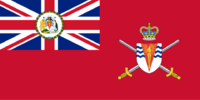Antarctic Circle States Army: Difference between revisions
(Created page with "{{wip}} {{Infobox law enforcement agency | agencyname = Furbish Gendarmerie | nativename = Furbiſh Gendarmerie | logo = Lesser coat of arms of the Fur...") |
No edit summary |
||
| Line 1: | Line 1: | ||
{{wip}} | {{wip}} | ||
{{Infobox law enforcement agency | {{Infobox law enforcement agency | ||
| agencyname = | | agencyname = A.C.S. Army | ||
| nativename = | | nativename = | ||
| logo = | | logo = [[File:A.C.S. Army Emblem.png|250px]] | ||
| logocaption = | | logocaption = '''A.C.S. Army Emblem''' | ||
| badge = | | badge = | ||
| badgecaption = | | badgecaption = | ||
| flag = Flag | | flag = [[File:ACS Army Flag.png|200px]] | ||
| flagcaption = Flag | | flagcaption = '''A.C.S. Army Flag''' | ||
| commonname = Gendarmerie | | commonname = Gendarmerie | ||
| abbreviation = GDM, FG | | abbreviation = GDM, FG | ||
Revision as of 20:22, 16 January 2023
This article is incomplete because it is pending further input from participants, or it is a work-in-progress by one author. Please comment on this article's talk page to share your input, comments and questions. Note: To contribute to this article, you may need to seek help from the author(s) of this page. |
| A.C.S. Army | |
|---|---|
 A.C.S. Army Emblem | |
 A.C.S. Army Flag | |
| Common name | Gendarmerie |
| Abbreviation | GDM, FG |
| Motto | Fidelis ad Mortem Faithful unto Death |
| Agency overview | |
| Formed | 1805 |
| Preceding agency |
|
| Employees | 228,138 |
| Volunteers | 43,285 |
| Annual budget | ƒ12.95 billion (₭25.33 billion) |
| Legal personality | Military branch |
| Jurisdictional structure | |
| National agency (Operations jurisdiction) | The Furbish Islands |
| Federal agency (Operations jurisdiction) | The Furbish Islands |
| Operations jurisdiction | The Furbish Islands |
| Size | 2,803,288 km2 |
| Population | 283,503,325 |
| Legal jurisdiction | |
| Governing body | Federal government of The Furbish Islands |
| Constituting instruments | |
| General nature | |
| Specialist jurisdictions |
|
| Operational structure | |
| Overviewed by | Ministry of the Gendarmerie |
| Headquarters | Fort McIntire, Capital District, The Furbish Islands |
| Gendarmes | 228,138 |
| Civilians | 51,830 |
| Ministers responsible | |
| Agency executives | |
| Parent agency | Ministry of the Gendarmerie |
| Components | |
| Facilities | |
| Commands | 5 regions 21 zones 103 provinces and territories 500 districts 2000 stations |
| Website | |
| gendarmerie.gov.fe | |
The Furbish Gendarmerie is a military branch tasked with law enforcement in The Furbish Islands.
History
Origins
The first mention of a national gendarmerie force was a clause in the 1805 constitution that allowed the government to establish an internal security force. The Gendarmerie was officially founded by Julian van Spijk in 1806, on the same day as the Army and Navy.
Second Republic and Time of Troubles
The Gendarmerie's role was expanded greatly under John Dodson.
Third Republic
Missions
Currently the Gendarmerie has the following missions:
- Assisting other law enforcement agencies, including local, provincial, and federal agencies
- Crowd control and security at large events
- Counterterrorism
- Disaster relief and search and rescue
- Law enforcement in areas occupied by the Furbish Army
- Maritime law enforcement and search and rescue
- Patrolling highways, railroads, and inland waterways
- Peacekeeping
- Protecting VIPs
- Riot control
- Security in airports, large train stations, nuclear power plants, and other sensitive locations
Organization
General staff
Provincial Gendarmerie
The Provincial Gendarmerie is the main branch of the Gendarmerie, making up around 150,000 gendarmes or about two thirds of the force. They are divided into 5 divisions serving 5 Gendarmerie regions, corresponding to Furbish regions with some surrounding territories. They are led by a lieutenant general. Regions are composed of 3-6 brigades, which are commanded by brigadier generals and serve a Gendarmerie zone, made up of 5 or 6 provinces or territories.
Regiments are the main administrative and operational unit of the Gendarmerie. They are led by a colonel and serve a province or territory. They are divided into 3-5 battalions, serving districts, which are commanded by a lieutenant colonel or a commandant depending on the size. Depending on the province or territory, battalions are split up into a number of stations across their district, usually housing a company led by a captain or a platoon and led by a lieutenant or sub-lieutenant. Companies are divided into a number of platoons, which are divided into squads, led by a sergeant, further divided into teams led by a corporal. The number and size of battalions and subordinate units varies significantly by province. In larger and more rural provinces, platoon sized stations are more common, while in more densely populated areas a station can house an entire company or even battalion.
All stations house gendarmes employed there and their families, and employ some civilians. They all have some basic services, including a reception desk open all hours of the day, office space, cells, and armories with spare weapons and vehicles. All stations also have helipads, but only battalion level and higher stations have helicopters assigned to them. Gendarmes assigned to guard locations typically reside in the nearest station, but some places, such as large airports and train stations, have small stations attached to them. Most gendarmes mostly patrol their areas, always in pairs, and reinforce other gendarmes or local law enforcement when needed.
A number of specialist regiments also exist. Though separate from the main Provincial Gendarmerie organization, provincial commanders have operational control over units in their area and are tasked with coordinating their actions. These are:
- Crisis negotiatiors, attached to battalions
- Inland waterway patrols, attached to battalions
- Juvenile delinquency prevention, attached to battalions
- Tactical teams, attached to battalions
- Criminal intelligence, attached to regiments
The second largest branch of the Gendarmerie, with around 50,000 gendarmes, is the Naval Gendarmerie, also known as the Furbish Coast Guard, which is tasked with maritime law enforcement, search and rescue, and disaster relief in coastal areas.
Mobile Gendarmerie
The mobile Gendarmerie has around 30,000 gendarmes. They are not permanently assigned to an area, and their main responsibility is to reinforce gendarmes anywhere in the country or abroad as needed, such as for riot control, security in major events, and major manhunts or counterterrorism operations. The Mobile Gendarmerie is also deployed abroad to provide security and law enforcement to areas under control of the Furbish military or peacekeepers.
The Mobile Gendarmerie is divided into 15 regiments and 7 brigades. Regiments are the main administrative unit, made up of 2-5 battalions but have no operational control over them, which is the task of the brigades. 5 of the brigades are part of each Gendarmerie Region while 2 are attached to EASTCOM and WESTCOM.
Special Intervention Force
The Special Intervention Force, or SIF, also known as the 143rd Gendarmerie Regiment, is the Gendarmerie's elite tactical unit and considered to be the most elite in the country and one of the most elite in the world. The SIF has a headquarters platoon, a training platoon, and 14 operations platoons, 2 assigned to each Gendarmerie region and 2 to both EASTCOM and WESTCOM. At least one platoon in each region is always kept on alert.
Ranks and Insignia
Personnel
Similar to the Furbish Army, the Gendarmerie uses the regimental system.